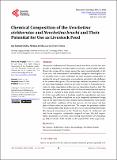| dc.contributor.author | Guchu, Ian Kimani | |
| dc.contributor.author | Ayieko, Monica | |
| dc.contributor.author | Okotto, Lorna-Grace | |
| dc.date.accessioned | 2023-12-08T09:01:05Z | |
| dc.date.available | 2023-12-08T09:01:05Z | |
| dc.date.issued | 2023-01-16 | |
| dc.identifier.citation | Guchu, I.K., Ayieko, M. and Okotto, L.-G. (2023) Chemical Composition of the Neochetina eichhor niae and Neochetina bruchi and Their Potential for Use as Livestock Feed. Advances in Entomology, 11, 38-46. | en |
| dc.identifier.issn | 2331-2017 (Online) | |
| dc.identifier.issn | 2331-1991 (Print) | |
| dc.identifier.uri | http://41.89.210.35/handle/123456789/13043 | |
| dc.description.abstract | Neochetina eichhorniae and Neochetina bruchi have been used for over four decades as Eichhorniae crassipes classical biological control agents globally. Despite the success of bio-control against the water hyacinth globally at different levels and environmental sustainability, biological control against water hyacinth seems to have overlooked the socio-economic sustainability in assisting the ravaged communities, gain resilience and adapt to the challenges of the invasive alien species. This manuscript evaluates the potential to draw out more from biological control of the water hyacinth by evaluating the potential to utilize Neochetina eichhorniae and Neochetina bruchi as feed. The live insects of the two species were collected from the water hyacinth marts in the nearby L. Victoria in Siaya county, Kenya. Where they were then transferred for semi-cultivation in localized ponds for reproduction and closer monitoring. The ponds having been set up in completely randomized design while in the open within the same climatic region mimicked the water quality and most abiotic conditions of the lake necessary for the insects’ and host plant acclimatization and reproduction. The samples for proximate analysis were collected from these ponds as per the research and experimental design.The chemical compositions of the Neochetina bruchi, N. eichhorniae and their larvae composite, satisfactorily compared to basic fish feed requirements, specifically as a protein source having crude protein (CP) percentage per DM of 55.0350 ± 0.025, 54.4350 ± 0.035 and 62.2750 ± 0.025 respectively. | en |
| dc.language.iso | en | en |
| dc.publisher | Scientific Research Publishing | en |
| dc.subject | Bio-Control | en |
| dc.subject | Eichhornia crassipes | en |
| dc.subject | Entomophagy | en |
| dc.subject | Neochetina bruchi | en |
| dc.subject | Neochetina eichorniae | en |
| dc.subject | Proximate | en |
| dc.title | Chemical Composition of the Neochetina eichhorniae and Neochetina bruchi and Their Potential for Use as Livestock Feed | en |
| dc.type | Article | en |
